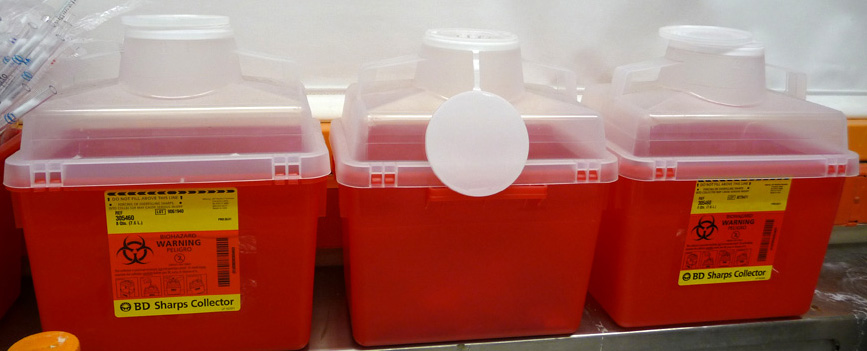Team:Brown/Human Practices/Safety
From 2010.igem.org
| Line 1: | Line 1: | ||
{{:Team:Brown/templates/header}} | {{:Team:Brown/templates/header}} | ||
| - | + | =Safety= | |
[[Image:safetypic.JPG]] | [[Image:safetypic.JPG]] | ||
Revision as of 16:26, 27 October 2010
Safety
General Safety
This year, our lab work was done in the Escherichia coli chassis. The NIH details proper safety practices for work involving Escherichia coli, which is an exemption under Section III-F-6. Appendix C-II "Escherichia coli K-12 Host-Vector Systems" suggests Biosafety Level I (BSL I) physical containment conditions1. Our team complied with these BSL I practices. Our work with E. coli does not pose any particular researcher, public, or environmental safety concerns given proper BSL I practices.
With regards to our specific project material, we were particularly careful to ensure we took the proper precautions. While our Light Pattern Controlled Circuit project does not raise any particular safety concerns beyond accommodations for work with E. coli, we noted some safety issues with the Tat protein transduction domain (Tat-ptd). This short amino acid sequence was originally obtained from the HIV virus - this short sequence allows the HIV virus to transduce across host membranes.
Tat-PTD safety
Our project presents Tat-PTD as a tool for the iGEM community, as we designed a cassette that allows a researcher to easily insert a protein of choice to be linked to the Tat-PTD. This gives a researcher the potential to carry any protein across a cell membrane. In this sense, our Tat-PTD cassette is a tool that is not inherently dangerous; there are no significant safety concerns in expressing the Tat-PTD. However, like any tool, our cassette could potentially be used in a harmful manner. Coupling the Tat-PTD / linker cassette with malignant proteins could have potentially devastating effects, given exposure (skin contact, ingestion) at a significant level, as this complex would permeate across many cells in the body. Thus, use of our Tat-PTD/linker cassette with human transcription factors or other sensitive material would require more sophisticated safety precautions.
In addition to examining the safety implications of fusing Tat-PTD to other proteins, we researched the cytotoxicity of the Tat-PTD itself. According to the literature, prolonged exposure of HeLa cells to Tat-PTD at very high concentration caused a significant amount of necrosis2. However, other studies shows that short exposure to Tat-PTD at concentrations of 20-100uM do not pose any level of toxicity3, so we suggest that any Tat-PTD fusion protein, regardless of what is fused to the transduction domain, be maintained at a level below 100uM.
Institutional Biosafety Regulation
Any member of the Brown University faculty, staff, post-doctoral, and student bodies who plans to initiate research involving human subjects must submit a protocol for review and approval by the Institutional Review Board (IRB) prior to beginning the project. The Research Protections Office (RPO) staff provides administrative support to researchers who are preparing protocols for presentation to the IRB.
The Institutional Animal Care & Use Committee (IACUC) ensures the health, well-being, and humane use of animals used in research at Brown, following the regulations and guidance of the U.S. Department of Agriculture and the Department of Health and Human Services. IACUC staff is available to answer administrative questions, and campus veterinarians can provide consultation and assistance on animal care and questions regarding experimental protocols. For our project, however, we have not yet proceeded to preclinical testing stage. For in vivo research, the Office of Environmental Health and Safety (EHS) at Brown provides compliance tools to optimize laboratory and facility conditions across research projects, from safe handling of potentially hazardous materials to biosafety training. EHS also has created guidelines to describe its emergency response system, environmental strategies, and lab equipment rules.
To learn more about what precautions should be taken with "normal" or "intended" use of our cassette, our team consulted the Office of Environmental Health and Safety at Brown University, where our research was conducted. The biological safety specialists at our institution advised us to follow BSL II procedures for work involving the expression of any Tat-fused proteins, despite the lack of expected human effects. For manipulations involving the Tat domain in DNA form, our existing BSL I protocols would be sufficient.
Each member of the team completed a Laboratory Safety course before beginning research in the lab. We obeyed all proper procedures including gloves, lab coats, accumulation and disposal of waste, chemical storage, laboratory security, and other EHS guidelines.
References
1)NIH Guidelines for Research Involving Recombinant DNA Molecules
2)E. Vives, P. Brodin, B. Lebleu, A truncated HIV-1 Tat protein basic domain rapidly translocates through the plasma membrane and accumulates in the cell nucleus, J. Biol. Chem. 272 (1997) 16010–16017.
3)M. Hallbrink, A. Floren, A. Elmquist, M. Pooga, T. Bartfai, U. Langel, Cargo delivery kinetics of cell-penetrating peptides, Biochim. Biophys. Acta 1515 (2001) 101–109.
 "
"


